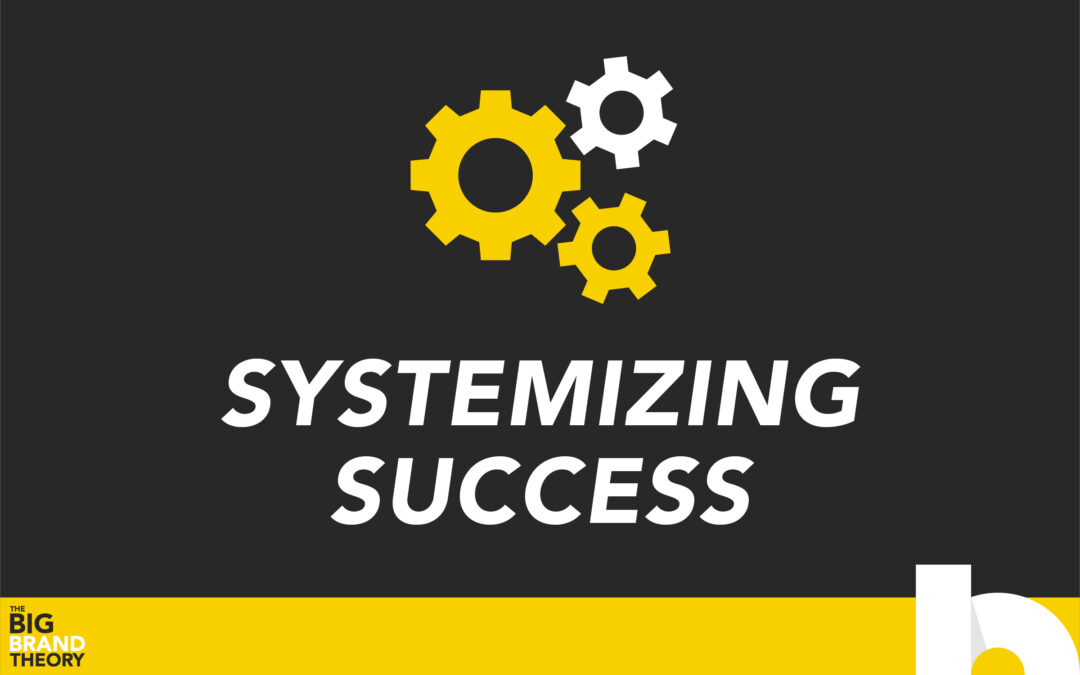On this episode of The Big Brand Theory, our host, Kyle Johnson spoke with Justin Maust, Leadership Trainer and owner of Rackley Restoration all about how to build and achieve your vision for your organization.
Justin helps clients with three things: building their vision, gaining traction and staying healthy. These three things are key components to all thriving businesses and are pretty commonly talked about. This issue isn’t always recognizing the concepts, it’s finding a place to start in your own business when it feels like you’re past the point of no return. Luckily, Justin is an expert on systemizing success and gave us a look into his process for his clients.

| BE ACCOUNTABLE |
First on your journey to systemizing success, your infrastructure has to be in place. This starts with operational systems. Justin recommends having a formal understanding that helps your team focus on common goals and enables them to execute everything well. In general, you have to have systems that keep your team on track and keep you focused. Just like Justin says,
“Demysitify your secret sauce”
Once your secret sauce is revealed, then you and your team can start actually getting to work in a healthy and productive way. This is your first step to systemizing success.
| VISION |
Next, you want to build out the core components of your vision. According to Justin, there are 8 components of vision. All of these components work together to not only identify a clear actionable vision, but to keep your team on track and accountable. One of Justins biggest points was that
“Culture eats strategy for lunch”
So, your vision needs to be down-packed before you begin your journey as a business. If it’s not, toxic culture will sweep up your strategy and your business will follow suit.

| CORE COMPONENTS OF VISION |
1. Core values: Focus on identifying and educating your team on your core values. Know them like the back of your hand.
2. Core focus: Ask yourself- what is your focus for this process?
3. 10 Year Target: Your 10 year target is another name for your company’s long-term goal. It should be specific and measurable.
4. Marketing Strategy: Your marketing strategy should allign with your values, focus, and should be a method to achieve your 10 year target.
5. 3 Year Picture: The 3 year picture should be long enough to be attainable but short enough to be measurable. Where do you want to be in 3 years and how are you going ot get there?
6. 1 Year Plan: Create your plan and scale it to be attainable within a years times. Your numbers won’t look huge and this clearly isn’t your ultimate goal, but it’s a method to achieve your 10 year target and 3 year picture.
7. 90 Day Rocks: Your 90 day rocks are distributed to everyone within your company. They should be something that is doable within 90 days but challanging enough to keep your employees working the whole 90-day period.
8. Issues List: Create a list of all potential issues that you may encounter on the way. The goal here is to be prepared for anything and everything you can face.

| THE ART OF THE EXPERIENCE |
“It’s not just what you communicate, it’s the experience that you deliver through your people.”
In the podcast, Justin used Steve Robinson as an example. He is famous for building the Chick-fil-A brand around an experience, not the product. Sure, the product is good. Chick-fil-A’s iconic waffle fries and chicken nuggets almost never sound like a bad idea. But, by ensuring consistency in kind customer service and hiring for culture, they created a unique fast-food experience like no other on the market today.
“Hire for culture, train for skill“
Similar to the Chick-fil-A example, you want to be sure that you’re hiring the right people, not just the people who are qualified. You can always train someone but you can’t teach the work ethic. You can explain all your systems to them but you can’t make them care. Focus on hiring people who have a personality that fits right into your business’s culture and then train them up. This is crucial in ensuring that you’re systemizing success.

| LOOK AT YOUR DATA |
“Artists, they go off feels way more than they go off of hard data. So getting the data right is keeping everybody focused on the truth.”
Sure, every now and then as a business leader, you have to go with your gut feeling. The problem with gut feelings is they won’t always be right. Justin was sure to emphasize that you should be making decisions based on data, not your gut. That’s not to say that your gut can’t inform some of your decisions, but to be sure you’re making the best decision for any situation, you need to look at the cold hard facts.
| IT ALL STARTS WITH LEADERSHIP |
“Success loves disciplines”
Everything in your business stems from the leader. Team leader, unit leader, CEO, whoever. If you’re a leader inside of a business (which theoretically means everyone), the success of your business relies on that. So, like Justin mentioned in the podcast, you need to be sure you’re a leader who is teaching discipline. Discipline is going to be the practice that changes everyone’s mindset.


| SCALING YOUR BUSINESS |
At the end of the day, if you want to scale your business, you need to remember Justin’s four rules:
1. Keep it simple
2. Make sure it’s repeatable
3. Ensure it’s transferable
4. Make sure that it’s healthy
If you like what you’re hearing and feel like you brand needs a boost, you’ve come to the right place. Our team of experts here at Blackwood Creative would be more than happy to work with you and help you meet and exceed your business goals. We’re in the business of building remarkable brands – yours could be next. Reach out to us today!

